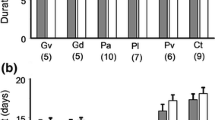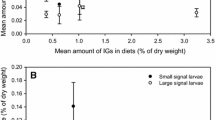Summary
Chrysomela confluens produces a salicylaldehyde-based defensive secretion which is very effective against generalist predators and apparently produced at no cost. If no cost defenses are common, then one of the basic assumptions in the plant-herbivore literature, i.e. tradeoffs among defense, reproduction, and growth, must be reconsidered. We examined the effectiveness of this defense by exposing defended larvae and larvae whose secretion had been removed to a generalist predator. Larvae which had their secretions intact were attacked by only 7% of the ants which encountered them, and none of these larvae suffered serious damage. In contrast, those which had been “milked” of their secretions immediately prior to exposure were attacked in 48% of such encounters, and two-thirds of the larvae were killed. Larvae which had been milked 24 or 72 h before exposure, then allowed to regenerate their defenses, were attacked at rates indistinguishable from larvae that had not been milked. Thus regenerated defenses are just as effective as original defenses. We also tested the hypothesis that the cost of defense production and maintainence would be reflected in reductions in developmental rates and final adult mass and increases in leaf consumption rate. We found that larvae which were milked daily of their secretions manifested no measurable cost of recharging reservoirs. Milked larvae grew and fed at the same rates as their control sibs, and became adults of equal or slightly larger size. The liberation of glucose from salicin, a precursor present in leaves of salicaceous hosts, during the production of salicylaldehyde apparently provides enough of an energetic benefit to offset the cost of maintaining an effective defense. Consistent with this hypothesis, we did not find that milked larvae compensated for increased nutritional or salicin demands by increasing their feeding rates. Although this patterns is familiar to chemical ecologists it is generally unappreciated in the plant-herbivore literature. It is likely that many arthropod herbivore defensive systems come at little or no cost, given the intimacy of association between herbivores and their food plants. Sequestration of host plant defensive chemicals which eliminates the cost of synthesis is common in arthropods. The de novo synthesis of chemical defenses may be less costly than expected if it is integrated into other parts of an insects metabolism. Calculations based on the bond energies or molecular constitution of the compounds will not yield a complete perception of cost. Tests over the life of the herbivore, coupled with an understanding of the herbivore's metabolism, are necessary.
Similar content being viewed by others
References
Adams RP, Hagerman A (1976) A comparison of the volatile oils of mature versus young leaves of Juniperus scopulorum: Chemosystematic significance. Biochem Syst Ecol 4: 75–79
Aldrich TR (1988) Chemical ecology of Heteroptera. Annu Rev Ecol Syst 33: 211–238
Baldwin IT, Dusenbery DB, Eisner T (1990) Squirting and refilling: dynamics of p-benzoquinone production in defensive glands of Diploptera punctata. J Chem Ecol 16: 2823–2834
Bengtsson G (1982) Energetic costs of amino acids exudation in the interaction between the predator Gammarus pulex L. and the prey Asellus aquaticus L. J Chem Ecol 8: 1271–1281
Blum MS (1978) Biochemical defenses of insects. In: Rockstein M (ed) Biochemistry of insects. Academic Press, New York, p. xiv + 649
Blum MS (1981) Chemical defenses of arthropods. Academic press, New York
Blum MS (1987) Biosynthesis of arthropod exocrine compounds. Annu Rev Ecol Syst 32: 381–413
Bowers MD, Puttick GM (1989) Iridoid glucosides and insect feeding preferences: Gypsy moths (Lymantria dispar, Lymantridae) and buckeyes (Junonia coenia, Nymphalidae). Ecol Ent 14: 247–256
Brattsten LB (1979) Biochemical defense mechanisms in herbivores against plant allelochemicals. In: Rosenthal GA, Janzen DH (eds) Herbivores: their interactions with secondary plant metabolities. Academic Press, Orlando, FL, pp 199–270
Brower LP, Brower JVZ (1964) Birds, butterflies and plant poisons: a study in ecological chemistry. Zoologica 49: 137–159
Brower LP, Glazier SC (1975) Localization of heart poisons in the monarch butterfly. Science 188: 19–25
Brower LP, McEvoy PB, Williamson KL, Flannery MA (1972) Variation in cardiac glycoside content of monarch butterflies from natural populations in eastern North America. Science 177: 426–429
Brown WJ (1956) The new world species of Chrysomela L. (Coleoptera: Chrysomelidae). Can Ent 88 [Suppl III]: 5–54
Bryant JP (1987) Feltleaf willow — snowshoe hare interactions: Plant carbon/nutrient balance and floodplain succession. Ecology 68: 1319–1327
Bryant JP, Chapin S, Klein DR (1983) Carbon/nutrient balance in boreal plants in relation to vertebrate herbivory. Oikos 40: 357–368
Coley PD, Bryant JP, Chapin FS (1985) Resource availability and plant antiherbivore defense. Science 230: 895–899
Dettner K (1987) Chemosystematics and evolution of beetle chemical defenses. Annu Rev Ecol Syst 32: 17–48
Dettner K, Schwinger G (1987) Chemical defense in the larvae of the leaf beetle Gonioctena viminalis (Coleoptera: Chrysomelidae). Experentia 43: 458–462
Duffey SS, Blum MS, Isman MB, Scudder GGE (1978) Cardiac glycosides: a physical system for their sequestration by the milkweed bug. J Insect Physiol 24: 639–645
Eisner T, Meinwald J (1966) Defensive secretions of arthropods. Science 153: 1341–1348
Eisner T, Johnessee JS, Carrel J, Hendry LB, Meinwald J (1974) Defensive use by an insect of a plant resin. Science 184: 996–999
Erickson JM (1973) The utilization of various Aesclepias species by larvae of the monarch butterfly, Danaus plexippus. Psyche 80: 230–244
Ferguson JE, Metcalf RL (1985) Cucurbitacins. Plant derived defense compounds for Diabroticites (Coleoptera: Chrysomelidae). J Chem Ecol 11: 311–318
Fescemyer HW, Mumma RO (1983) Regeneration and biosynthesis of Dytiscid defensive scents (Coleoptera: Dytiscidae). J Chem Ecol 9: 1449–1464
Franke A, Rimpler H, Schneider D (1987) Iridoid glycosides in the butterfly Euphydrias cynthia (Lepidoptera: Nymphalidae). Phytochemistry 26: 103–106
Harborne JB (1979) Flavanoid pigments. In: Rosenthal GA, Janzen DB (eds) Herbivores: their interactions with secondary plant metabolites. Academic Press, Orlando, FL, pp 619–655
Hay ME, Fenical W (1988) Marine plant-herbivore interactions: the ecology of chemical defense. Annu Rev Ecol Syst 19: 111–145
Hetz M (1988) Costs and benefits of mimicry. Ph.D. Dissertation. Northern Arizona University, Flagstaff, Arizona. vii + 66 pages
Hill CS, Tschinkel WR (1985) Defensive secretion production in the tenebrionid beetle Zophobas attratus: effects of age, sex, and milking frequency. J Chem Ecol 11: 1083–1092
Jensen KR (1984) Defensive behavior and toxicity of Ascoglossan opisthobranch Mourgona germaineae. J Chem Ecol 10: 475–486
Jones CG, Hess TA, Whitman DW, Silk PJ, Blum MS (1987) Effects of diet breadth on autogenous chemical defense of a generalist grasshopper. J Chem Ecol 13: 283–297
Jonsson S, Bergstrom G, Lanne BS, Stensdotter U (1988) Defensive odor emission from larvae of two sawfly species, Pristiphora erichsoni and P. wesmaeli. J Chem Ecol 14: 713–721
Kearsley MJC, Whitham TG (1989) Developmental changes in resistance to herbivory: implications for individuals and populations. Ecology 70: 422–434
Kingsbury JM (1964) Poisonous plants of the United States and Canada. Prentice-Hall, Englewood Cliffs, NJ
Larsson S, Wiren A, Lundgren L, Ericsson T (1986) Effects of light and nutrient stress on leaf phenolic chemistry in Salix dasyclados and susceptibility, to Balerucella lineola (Coleoptera). Oikos 47: 205–210
Lindroth RL, Scriber JM, Hsia MTS (1988) Chemical ecology of the tiger swallowtail: mediation of host use by phenolic glucosides. Ecology 69: 814–822
Luckner M (1984) Secondary metabolism in microorganisms, plants, and animals. Second ed. Springer-Verlag, New York
Matsuda K, Matsuo H (1985) A flavonoid, Luteolin-7-glucoside, as well as salicin and populin, stimulating the feeding of leaf beetles attacking salicaceous plants. Appl Ent Zool 20: 305–313
Meinwald J, Jones TH, Eisner T, Hicks K (1977) New methylcyclopentanoid terpenes from the larval defensive secretion of a chrysomelid beetle (Plugiodera versicolora). Proc Nat Acad Sci, USA 74: 2189–2193
Morrow PA, Bellas TE, Eisner T (1976) Eucalyptus oils in the defensive oral discharge of Australian sawfly larvae (Hymenoptera: Pergidae). Oceologia 24: 193–206
Nahrstedt A, Davis RH (1983) Occurrence, variation, and biosynthesis of the cyanogenic glucosides Linamarin and lotaustralin in species of the Heliconiini (Insecta: Lepidoptera). Comp Biochem Physiol 75B: 65–73
Nishida R, Fukami H (1989) Host plant iridoid-based chemical defense of an aphid, Acrythosiphon nipponicus, against ladybird beetles. J Chem Ecol 15: 1837–1845
Palo RT (1984) Distribution of birch (Betula spp.), willow (Salix spp.), and poplar (Populus spp.) secondary metabolites and their potential role as chemical defense against herbivores. J Chem Ecol 10: 499–520
Pasteels JM, Daloze D (1977) Cardiac glycosides in the defensive secretion of Chrysomelid beetles: evidence for their production by the insects. Science 197: 70–72
Pasteels JM, Gregoire JC (1983) The chemical ecology of defense in arthropods. Annu Rev Entomol 28: 263–289
Pasteels JM, Daloze D, Dorsser W van, Roba J (1979) Cardiac glycosides in the defensive secretion of Chrysolina herbacea (Coleoptera: Chrysomelidae). Identification, biological role and pharmacological activity. Comp Biochem Physiol 63C: 117–121
Pasteels JM, Braekman JC, Daloze D, Ottinger R (1982) Chemical defense in Chrysomelid larvae and adults. Tetrahedron 38: 1891–1897
Pasteels JM, Rowell-Rahier M, Braekman JC, Dupont A (1983) Salicin from host plant as precursor of salicylaldehyde in defensive secretion of Chrysomeline larvae. Physiol Ent 8: 307–314
Pasteels JM, Rowell-Rahier M, Brakeman J-C, Daloze D (1984) Chemical defenses in leaf beetles and their larvae: the ecological, evolutionary and taxonomic significance. Biochem Syst Ecol 12: 395–406
Pasteels JM, Rowell-Rahier M, Braekman JC, Daloze D, Duffey S (1989) Evolution of exocrine chemical defense in leaf beetles (Coleoptera: Chrysomelidae). Experentia 45: 295–300
Pasteels JM, Duffey S, Rowell-Rahier M (1990) Toxins in Chrysomelid beetles. Possible evolutionary sequence from de novo synthesis to derivation from food-plant chemicals. J Chem Ecol 16: 211–222
Prestwich GD (1983) The chemical defenses of termites. Sci Amer 249: 78–87
Price PW (1987) The role of natural enemies is insect populations. In: Barbosa P, Schultz JC (eds) Insect Outbreaks. Academic Press, New York, pp 287–312
Price PW, Westoby M, Rice B (1988) Parasite-mediated competition: some predictions and tests. Am Nat 131: 544–555
Reichstein T, Euw J von, Parsons JA, Rothschild M (1968) Heart poisons in the monarch butterfly. Science 161: 861–866
Robinson T (1974) Metabolism and function of alkaloids in plants. Science 184: 430–435
Rosenthal GA, Janzen DH (1979) Herbivores: their interaction with secondary plant metabolites. Academic press, Orlando, FL
Roth LM, Eisner T (1962) Chemical defenses in arthropods. Annu Rev Entomol 7: 107–136
Rowell-Rahier M, Pasteels JM (1982) The significance of salicin for a Salix-feeder, Phratora (Phyllodecta) vitellinae. In: Visser JH, Minks AK (eds) Proceedings of the 5th International Symposium on Insect-Plant Relationships. Pudoc, Wageningen, pp. 73–79
Rowell-Rahier M, Pasteels JM (1986) Economics of chemical defense in Chrysomelinae. J Chem Ecol 12: 1189–1203
Schulte G, Scheuer PJ, McConnell OJ (1980) Two furanosesquiterpene marine metabolites with antifedant properties. Helv Chim Acta 63:2159–2167
Seigler D, Price PW (1976) Secondary compounds in plants: primary functions. Am Nat 110:101–105
Smiley JT, Horn JM, Rank NE (1985) Ecological effects of salicin at three trophic levels: new problems from old adaptations. Science 229:649–651
Stermitz FR, Gardner DR, Odendaal FJ, Erlich PR (1986) Euphydryas anicia (Lepidoptera: Nymphalidae) utilization of iridoid glycosides from Castilleja and Besseya (Scrophulariaceae) host plants. J Chem Ecol 12:1459–1468
Stermitz FR, Gardner DR, McFarland N (1988) Iridoid glycoside sequestration by two aposematic Penstemmon-feeding Geometrid larvae. J Chem Ecol 14:435–441
Thompson JE, Walker RP, Wratten SJ, Faulkner DJ (1982) A chemical defense mechanism for the nudibranch Cadlina luteomarginata. Tetrahedron 38:1865–1873
Vaughan GL, Jungreis AM (1977) Insensitivity of Lepidopteran tissues to Ouabain: physiological mechanisms for protection from cardiac glycosides. J Insect Physiol 23:585–593
Whitham TG (1989) Plant hybrid zones as sinks for pests. Science 244:1490–1493
Witz BW, Mushinsky HR (1989) Pygidial secretions of Pasimachis subsculatus (Coleoptera: Carabidae) deter predation by Eumeces inexpectatus (Squamata; Sinaidae). J Chem Ecol 15:1033–1044
Author information
Authors and Affiliations
Rights and permissions
About this article
Cite this article
Kearsley, M.J.C., Whitham, T.G. Guns and butter: a no cost defense against predation for Chrysomela confluens . Oecologia 92, 556–562 (1992). https://doi.org/10.1007/BF00317849
Received:
Accepted:
Issue Date:
DOI: https://doi.org/10.1007/BF00317849




